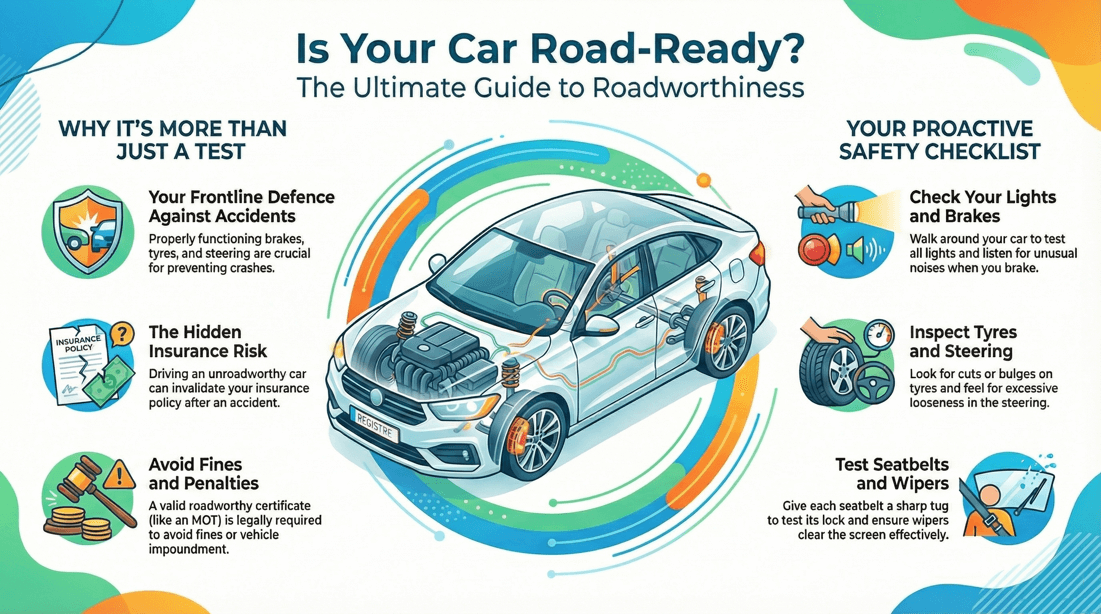
MAINTENANCE > ROADWORTHY
Roadworthy
☠️ Alert:
? Questions:


☠️ The importance of a vehicle being roadworthy
Safety: A roadworthy vehicle reduces the risk of accidents and ensures the safety of passengers, other road users, and pedestrians . Components such as brakes , tires , lights , steering , and suspension are critical for safe operation on public roads. Legal Compliance: Many jurisdictions require vehicles to undergo periodic roadworthiness inspections or have valid certificates of roadworthiness (such as MOT tests in the UK). Compliance with these regulations is essential to avoid fines, penalties, or restrictions on vehicle use. Operational Efficiency: Vehicles that are roadworthy are more reliable and perform efficiently. Properly maintained components contribute to better fuel efficiency , reduced emissions, and overall smoother operation. Insurance Requirements: Insurance coverage often requires that vehicles are roadworthy. Driving an unroadworthy vehicle could invalidate insurance policies, leaving the driver liable for damages or injuries in the event of an accident. Public Confidence: Roadworthy vehicles contribute to public confidence in transportation systems. Drivers and passengers can trust that vehicles on the road meet minimum safety and operational standards, promoting trust in regulatory authorities and vehicle manufacturers. Environmental Impact: Roadworthy vehicles that are properly maintained tend to have lower emissions, contributing to environmental protection and reducing the overall impact on air quality and pollution levels. Resale Value: Well-maintained and roadworthy vehicles typically retain higher resale value. Buyers prefer vehicles that have a documented history of regular maintenance and compliance with roadworthiness standards. Personal Well-being: Driving a roadworthy vehicle enhances the driver's peace of mind and reduces stress associated with mechanical failures or breakdowns on the road.
? How often should I get my vehicle inspected for roadworthiness?
Annual Inspections: In many countries, vehicles typically require an annual inspection to ensure they meet roadworthiness standards. This inspection often includes checks on brakes, lights, tires, suspension, steering, and emissions. New Vehicles: New vehicles may not require inspections immediately but may need periodic inspections as they age. Check local regulations for specific requirements. High Mileage Vehicles: Vehicles with high mileage or heavy use may need more frequent inspections to maintain roadworthiness. After Accidents or Modifications: Following accidents or significant modifications (such as changes to suspension or engine modifications), it's advisable to have the vehicle inspected to ensure it remains roadworthy. Regular Maintenance Checks: Even if not required by law, regular maintenance checks by a qualified mechanic are crucial to maintain vehicle safety and performance. Check Manufacturer Recommendations: Refer to the vehicle owner's manual or manufacturer's recommendations for specific maintenance and inspection intervals . Personal Checks: Regularly check basic components such as lights , brakes , tires , and fluids to ensure they are in good condition.
? Is
it legal to drive without a valid roadworthy certificate?
When is a roadworthy certificate legally required?
When selling a vehicle: The seller must provide a valid roadworthy certificate to the buyer before transferring ownership. When re-registering a vehicle: This includes vehicles that have been deregistered or are being imported. When converting a vehicle from unfit to roadworthy status. During random checks or roadblocks: Authorities may request proof that your vehicle meets safety standards.
What are the legal consequences of driving without one?
Fines or penalties: Law enforcement can issue fines if your vehicle is found to be unroadworthy or without a valid certificate. Vehicle impoundment: In some cases, the vehicle may be impounded until it passes inspection. Insurance issues: Driving without a valid certificate could void your insurance if you're involved in an accident. Registration delays or cancellation: Without a valid roadworthy certificate, you may not be able to renew your vehicle registration.
Key exceptions:
The vehicle is already registered and hasn’t changed ownership. You are not required to re-license the vehicle under special circumstances.
Conclusion:
? What components are checked during a roadworthiness inspection?
Brakes : Inspection of brake pads, discs or drums, brake lines, hoses, and the brake fluid level to ensure they are in good condition and provide effective braking. Lights : Functionality and alignment of headlights (low and high beam), taillights , brake lights , turn signals , hazard lights , and license plate lights. Tires : Tread depth to ensure sufficient grip on the road surface, tire condition (e.g., cuts, bulges), and tire pressure to meet manufacturer's specifications. Steering and Suspension : Inspection of steering components for wear or damage, play in the steering wheel, and proper alignment. Suspension components are checked for wear, leaks, and proper functioning. Wheels and Wheel Bearings: Condition of wheels (e.g., cracks, bends) and wheel bearings to ensure they are secure and free of excessive play. Seatbelts and Seats: Functionality and condition of seatbelts, including the locking mechanism and webbing condition. Seats are checked for secure mounting and condition. Exhaust Emissions: Inspection of exhaust system components to ensure they are securely attached and emit exhaust gases within permissible limits. Body and Chassis: Inspection for structural integrity, corrosion, and damage to the bodywork and chassis that could affect the vehicle's safety. Windshield and Wipers : Condition and visibility of the windshield, including any cracks or chips that could impair the driver's view. Wiper blades are checked for proper operation and condition. Fluid Levels : Inspection of fluid levels, including engine oil, coolant, brake fluid, power steering fluid, and windshield washer fluid, to ensure they are at appropriate levels. Electrical System: Battery condition and security, operation of dashboard instruments and indicators, horn functionality, and electrical wiring integrity. General Operation: Checks on the general operation of the vehicle, including the clutch (if applicable), gearbox operation, and engine performance.
? Are emissions tested as part of roadworthiness?
Why are emissions tested?
What is tested during an emissions check?
Exhaust gases are analyzed using a gas analyzer or onboard diagnostics (OBD) tool. Smoke levels are checked for diesel vehicles (to detect issues like worn injectors or a failing turbo). Catalytic converters and oxygen sensors are examined to ensure proper function. Idle speed and fuel mixture may also be reviewed to confirm efficiency and proper combustion.
When might a vehicle fail an emissions test?
Faulty or missing catalytic converter Engine misfire or poor maintenance Dirty air filter or malfunctioning fuel injectors Faulty oxygen sensor Use of incorrect fuel or additives
How to prepare for an emissions test:
Get a tune-up and replace dirty filters Repair any engine warning lights (especially the “Check Engine” light) Avoid short trips before testing (a warm engine performs better) Use high-quality fuel and consider a fuel system cleaner
Conclusion:
? What happens if my vehicle fails the roadworthy test?
1. You'll receive a rejection report.
2. Repairs must be completed before retesting.
3. You cannot register or sell the vehicle.
4. Your vehicle remains unlicensed or suspended.
How to avoid failing the roadworthy test:
Regularly service your car. Check tires, brakes, lights, wipers, and suspension. Fix dashboard warning lights and leaks promptly. Keep the vehicle clean and well-maintained.
Conclusion:
Failing the roadworthy test delays your ability to legally drive or sell your vehicle, but it’s also a vital opportunity to fix serious safety issues. Taking preventative care and addressing minor problems early can save you time, money, and ensure your car is safe for the road.
? How can I tell if my vehicle is roadworthy?
Regular Inspections: Schedule regular inspections with a qualified mechanic or authorized testing facility as per local regulations. They can conduct comprehensive checks to ensure all components meet roadworthiness standards. Check Lights and Signals : Test headlights (low and high beam), taillights, brake lights, turn signals, hazard lights, and license plate lights to ensure they are working correctly and are not damaged. Inspect Brakes : Check brake pedal responsiveness, brake fluid levels, and listen for unusual noises when braking. Ensure there is no excessive brake pedal travel or vibration, which could indicate brake issues. Examine Tires : Inspect tire tread depth using a tread gauge or the penny test (where Lincoln's head is partially covered by the tread). Check for signs of uneven wear, cuts, bulges, and ensure tires are inflated to the manufacturer's recommended pressure. Test Steerin g and Suspension : Turn the steering wheel to check for excessive play or stiffness. Listen for unusual noises when turning. Inspect suspension components for leaks, wear, or damage. Assess Seatbelts : Check the condition of seatbelt webbing and ensure the mechanism locks properly under sudden jerks. Verify that seatbelt anchors are secure. Evaluate Fluid Levels : Check engine oil, coolant, brake fluid, power steering fluid, and windshield washer fluid levels. Top up fluids as necessary to maintain optimal performance. Inspect Windshield and Wipers : Ensure the windshield is free of cracks or damage that impairs visibility. Test wiper blades for effective operation, replacing them if streaking occurs. Check Exhaust System: Inspect the exhaust system for leaks, rust, or damage. Listen for abnormal noises or excessive smoke emissions, which may indicate problems. General Condition: Walk around the vehicle to inspect for body damage, rust, or corrosion. Check that all doors, windows , and mirrors operate correctly. Drive and Listen: Take a short drive to assess the vehicle's handling, engine performance, and transmission operation. Listen for unusual engine noises, vibrations, or warning lights on the dashboard. Review Maintenance Records : Keep records of regular maintenance, servicing, and repairs. This helps track the vehicle's history and ensures it receives necessary attention.
? What should I do if I suspect my vehicle is not roadworthy?
Stop Driving Immediately: If you notice significant safety concerns such as brake failure, steering issues, or major mechanical problems, pull over to a safe location as soon as possible. Avoid driving further until the issue is resolved. Assess the Situation: Conduct a thorough visual inspection of the vehicle to identify any visible signs of damage, wear, or malfunction. Check critical components such as brakes , tires , lights , steering , and suspension . Seek Professional Inspection: Contact a qualified mechanic or take your vehicle to an authorized testing facility for a comprehensive inspection. They can diagnose any issues and provide recommendations for repairs or maintenance. Address Immediate Safety Concerns: If you identify minor issues that can be fixed on the spot (e.g., replacing a blown bulb , topping up fluids ), address them promptly to improve safety. Document Concerns: Keep detailed notes or records of your observations regarding the vehicle's condition. Note any symptoms, noises, or warning lights that may indicate problems. Follow Local Regulations: Depending on your location, certain safety issues may require immediate rectification or may prevent legal operation of the vehicle. Familiarize yourself with local laws and regulations regarding roadworthiness. Repair or Replace Components: Based on the inspection findings, follow the mechanic's recommendations to repair or replace faulty components. Ensure that repairs are performed by qualified professionals using appropriate parts. Regular Maintenance: Establish a regular maintenance schedule to keep your vehicle in optimal condition. This includes scheduled inspections, oil changes, tire rotations , and other preventative measures to ensure ongoing roadworthiness. Safety First: Prioritize safety at all times. Do not compromise on repairs or maintenance that could affect your safety or the safety of others on the road.
? Can modifications affect a vehicle's roadworthiness?
Safety Features: Modifications that affect safety features such as airbags, seatbelts , or structural components can reduce the vehicle's ability to protect occupants in the event of a collision. Suspension and Steering : Changes to suspension height or stiffness, as well as alterations to steering components, can affect handling and stability, potentially compromising vehicle control. Braking System: Modifications to braking components, such as installing aftermarket brakes or altering brake lines, may impact braking performance and reliability. Exhaust System: Modifying the exhaust system, including installing aftermarket exhausts or catalytic converter deletions, can affect emissions compliance and may increase noise levels. Lighting and Signals : Changes to lighting systems, including installing aftermarket headlights, taillights, or turn signals, may affect visibility and compliance with lighting regulations. Tires and Wheels : Installing non-standard tires or wheels that are not compatible with the vehicle's specifications can affect handling, braking, and steering. Engine and Performance Modifications: Alterations to the engine, such as tuning for increased horsepower or modifying fuel systems, can affect emissions compliance, fuel efficiency, and overall engine reliability. Legal Compliance: In many jurisdictions, modifications that deviate from the vehicle manufacturer's specifications may require approval or certification to ensure compliance with roadworthiness regulations.